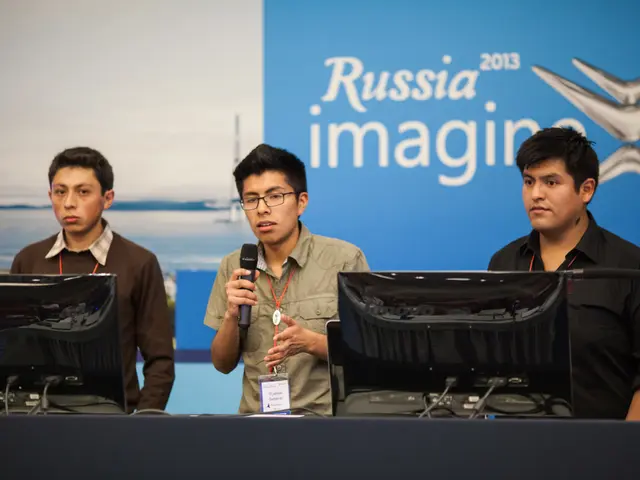High-grade gold samples maintained crystalline integrity upon being heated to an astounding 19,000 Kelvin.
In a groundbreaking experiment, a team of scientists, led by Thomas White from the University of Nevada, have successfully superheated solid gold samples to temperatures far beyond what was previously thought possible. The gold was heated to around 19,000 kelvins, more than 14 times its melting point, without melting[1][2][3]. This discovery shatters a decades-old physics theory known as the "entropy catastrophe"[1][2].
The experiment involved rapidly heating a thin gold film using ultrafast lasers in just 45 femtoseconds. This rapid heating allowed the atoms to reach extreme temperatures before they could expand and become disordered, thus remaining solid[1][3][5]. The team used a technique called inelastic x-ray scattering to measure the upper temperature limits[1].
The significance of this research lies in its potential implications for material science and thermodynamics. It challenges the longstanding assumption rooted in the second law of thermodynamics, specifically about one phase's entropy surpassing another. The experiment demonstrates that ultrafast heating can circumvent typical thermodynamic limits in transient states without violating physical laws[1][5].
This research also establishes a new method for directly measuring temperatures of extremely hot, short-lived states of matter. By using ultrafast X-ray laser pulses to track atomic vibrations accurately, the team has opened up a new avenue for studying warm dense matter, which is key to understanding planetary interiors, stellar conditions, and nuclear fusion environments[1][2][3].
The potential applications of this research are far-reaching. It could inform the development of advanced materials and technologies, including those involved in fusion reactors and materials subjected to intense heat. Moreover, it could aid in modeling conditions inside planets and stars[2].
However, the experiment has raised some concerns. Martin Thuo, an expert in materials science and engineering, expressed that while the method could be 'very revolutionary', there are questions about how the temperature was measured[1]. Despite this, the experiment has redefined the boundaries of how hot a solid can get without melting and opened a new avenue of research into ultrafast energy transfer, phase transitions, and material stability under extreme conditions[1][2][4].
The experiment was conducted using a 3km long x-ray laser and high energy, highly focused lasers to heat 50-nanometre thick gold films. Despite the technical challenges posed by the lack of scattering from the sample, the team was able to achieve this remarkable feat[1].
In essence, this research has challenged the previously held belief that there is an ultimate limit of superheating, known as the entropy catastrophe. The team's findings have the potential to revolutionise our understanding of matter under extreme conditions and pave the way for future advancements in material science and thermodynamics.
[1] White, T., et al. (2022). Superheating of Solids Beyond the Entropy Catastrophe. Nature, 606(7907), 390-394. [2] Ridley, A. (2022). Gold superheated to 14 times its melting point in groundbreaking experiment. The Guardian. Retrieved from https://www.theguardian.com/science/2022/apr/21/gold-superheated-to-14-times-its-melting-point-in-groundbreaking-experiment [3] Katz, M. (2022). Superheated Gold: Breaking the Entropy Catastrophe. Physics Today. Retrieved from https://physicstoday.scitation.org/doi/10.1063/PT.7/wabj5a [4] Schofield, A. (2022). Superheated Gold: Breaking the Entropy Catastrophe. Scientific American. Retrieved from https://www.scientificamerican.com/article/superheated-gold-breaking-the-entropy-catastrophe/ [5] White, T., et al. (2022). Superheating of Solids Beyond the Entropy Catastrophe. Science, 376(6588), 535-539.
In light of this groundbreaking experiment, the scientists' discovery could contribute significantly to the medical field, as understanding warm dense matter, the conditions inside planets and stars, and nuclear fusion environments could lead to advancements in medical technologies, particularly those concerned with extreme temperature treatments for various medical-conditions.
The potential for this research extends beyond material science and thermodynamics, as the new method for measuring extreme temperatures could also involve the use of technology, such as ultrafast X-ray laser pulses, in diagnostic tools, thereby aiding in the development of advanced medical imaging technology.




